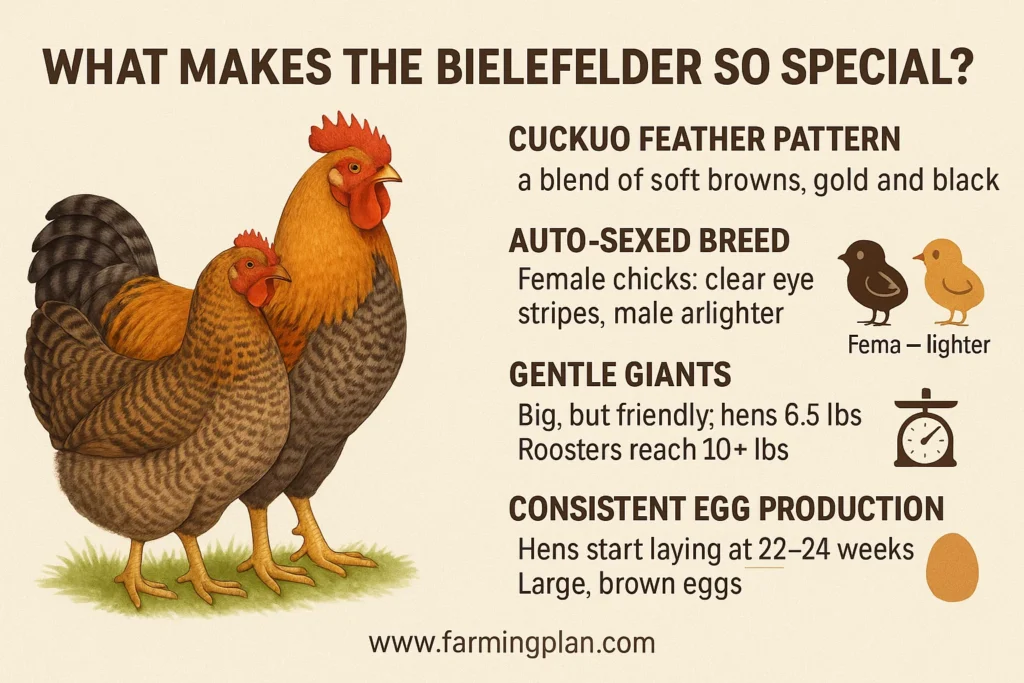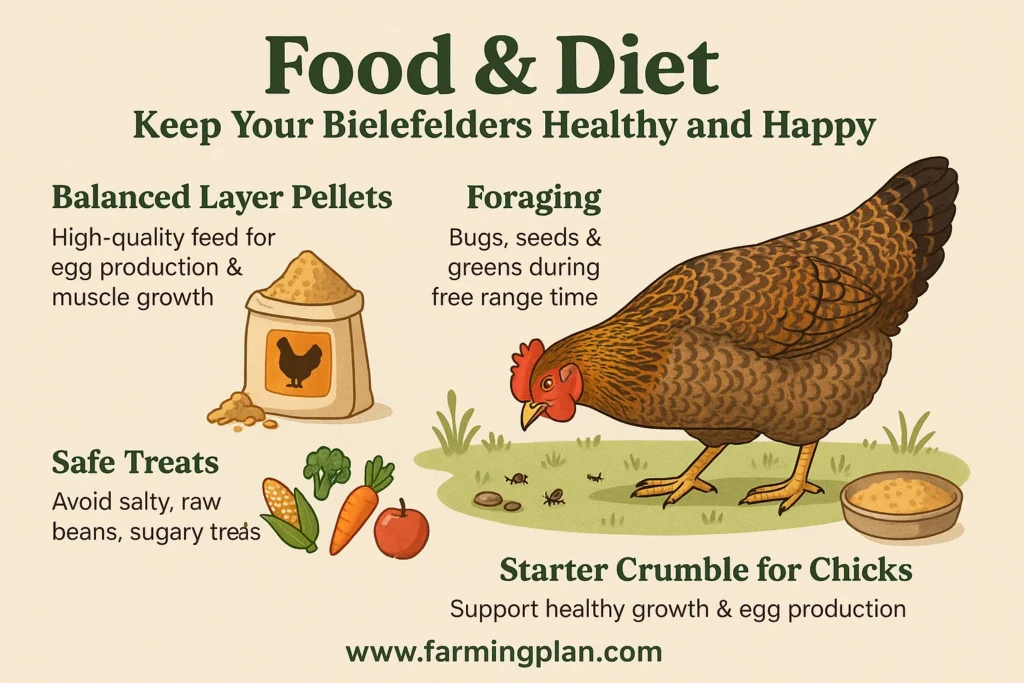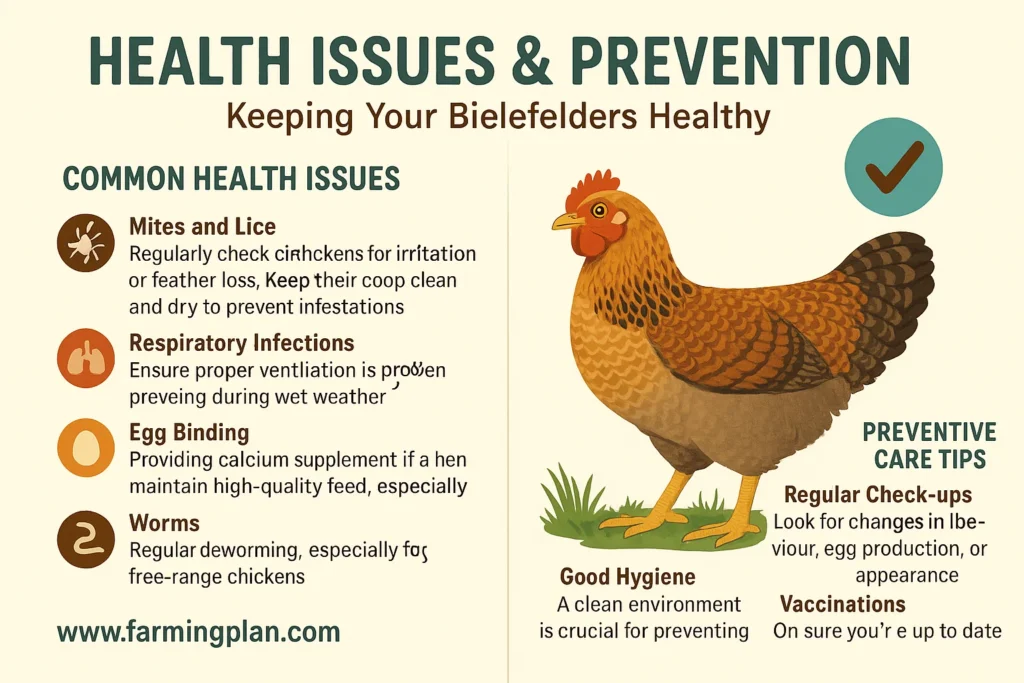Looyou’reo, add a unique, beautiful, and productive bird to your backyard flock? The Bielefelder Kennhuhn Chicken might just be the perfect fit. This exceptional breed is renowned for its gentle nature, striking cuckoo feather pattern, and robust egg-laying ability. As a dual-purpose breed, the Bielefelder offers both consistent egg production and high-quality meat yield, making it a top choice for hobbyists, breeders, and farmers. Its auto-sexing trait, which allows even beginners to easily distinguish male and female chicks from day one, adds to its appeal. Whether you’re managing a balanced flock or just starting with a few chicks, this German-born beauty is a reliable and friendly addition to any coop.

History & Origin
The Bielefelder Kennhuhn Chicken, a breed that originated in the 1970s, was the brainchild of a skilled German chicken breeder named Gerd Roth. Roth, who resided in the town of Bielefeld, where the breed gets its name, had a vision of creating the ultimate chicken—productive, friendly, and attractive. To achieve this, he crossed several strong and reliable breeds, including Ameraucana chickens, Welsummers, and Rhode Island Reds.
The result was a robust dual-purpose breed that could thrive in cold climates, lay abundant eggs, and provide high-quality meat. Over time, the Bielefelder earned a solid reputation in Germany and across Europe. Today, it’s a favorite among backyard chicken keepers around the world. Its popularity keeps growing thanks to its calm behavior, easy-to-handle size, and eye-catching feather pattern.
Reads More: Silver Appleyard Duck – The Ultimate Friendly Farm Favorite
Characteristics
The Bielefelder Kennhuhn Chicken is a standout in any flock. It’s a large bird with a striking cuckoo feather pattern—a blend of soft browns, gold, and black that creates a unique striped effect. Both the hens and the handsome roosters are visually striking, with roosters often displaying more golden tones on their neck and back.

One of the breed’s most unique traits is that it’s an auto-sexed breed. This means you can tell male and female chicks apart just by looking at them on the day they hatch. Female chicks are darker with clear eye stripes, while males are lighter.
These chickens are often called gentle giants because they’re big, but they’re friendly. Hens typically weigh around 6.5 pounds, and roosters can reach 10 pounds or more. Even with their size, they’re easy to reach and great for beginners. They also start laying early—most hens begin producing large, brown eggs at around 22–24 weeks of age. These chickens are known for consistent egg production, making them a reliable choice for anyone wanting fresh eggs daily.
Nature & Temperament of Bielefelder Kennhuhn chicken
The Bielefelder Kennhuhn Chicken is known for its gentle nature and calm personality. If you’re tired of your vicious birds or dealing with pecking order disputes, this breed can bring peace to your coop. Many keepers call them the “kinder chicken” because they “et al, ong so well with humans and other animals. Even the roosters are well-behaved.
Unlike some breeds that turn into crazed psychopath bird, Bielefelder roosters are often calm and protective roosters, making them a safe choice for families with kids. These chickens are easy to manage in mixed flocks and don’t bully, so they don’t breed. They don’t make a noise, which is great if you have neighbors nearby. Their calm nature also makes daily chicken chores much easier and more enjoyable.
Food & Diet of Bielefelder Kennhuhn chicken
Feeding your Bielefelder Kennhuhn Chicken the right diet is key to keeping it healthy and productive. These birds do best on a high-quality feed that supports both egg production and muscle growth. Look for balanced layer pellets once they start laying eggs.

As dual-purpose birds, they also enjoy foraging. They’ll happilyThey’ll for bugs, seeds, and greens during free-range time. Still, you should always give them plenty of clean feed and water. When foraging, these birds are smart and know how to lead their girls to food without much fuss.
For baby chicks, including Bielefelder baby chicks, use a starter crumble that’s high in that. As they grow, slowly move them to grower feed, then to layer feed around 18–20 weeks. This supports healthy growth and prepares them for strong egg production. Avoid giving “hem salty snacks, raw beans, or sugary treats. Stick with safe fruits, veggies, grains, and protein-rich kitchen scraps when you want to treat them.
Tip: Always offer c “ushed oyster shells in a separate dish—this helps hens lay stronger, healthier eggs.
Usage & Purpose
The Bielefelder Kennhuhn Chicken is often called a true dual-purpose bird—and for good reason. It delivers both excellent egg production and quality meat, making it a smart choice for families, hobby farmers, and breeders. Hens lay around 230–280 large brown eggs each year. That means you can count on fresh eggs almost every day without long production vacations. Their eggs are not only tasty but also strong-shelled, thanks to their balanced diet and strong genetics. When it comes to meat, the Bielefelder grows fast and fills out nicely.
Roosters provide a lot of meat per bird, making them classic meat birds that fit well into sustainable living plans. Because they’re so easythey’rese and handle, they’re a favorthey’reng people building a balanced flock. These chickens also make great additions to backyard chickens setups, especially for those who want both beauty and purpose in their coop. Whether you’re in it for you, meat, or just a remarkable bird to enjoy around your yard, the Bielefelder does it all.
“Raising Bielefelder Kennhuhn Chickens Brings Joy and Sustainability To Your Backyard Flock, One Egg At A Time!”
Special Features
The Bielefelder Kennhuhn Chicken isn’t just another in the coop—it’s packed with traits that make it one of the most wonderful chickens you can raise. One standout feature is its auto-sexing trait. This means you can spot female baby chicks and males right after hatching. No guessing. This is a big help for breeders and anyone buying a couple of chicks for their backyard.
Another amazing feature is their stunning cuckoo pattern. These gorgeous birds look stylish and stand out in any flock. They also handle cold weather well, thanks to their dense feathers. Because they are so large and friendly, they’re often gentle giants. They’re calm, don’t eat, and make perfect companions for beginners or families. The breed’s production, peaceful behavior, and ability to live in mixed flocks all add to its charm. It’s no wonder that Bielefelder is known as a “super chicken” by those who “eep them.
Health Issues & Prevention of Bielefelder Kennhuhn chicken
The Bielefelder Kennhuhn Chicken is a hardy breed, but like all chickens, they’re susceptible to a few common health issues. Thankfully, with proper care, most of these problems can be prevented.

Common Health Issues
- Mites and Lice: These pests can affect any flock. Regularly check your chickens for signs of irritation or feather loss. Keep their coop clean and dry to prevent infestations.
- Respiratory Infections: Like many chickens, Bielefelders can get respiratory illnesses if exposed to wet or cold environments. Make sure they have proper ventilation and stay dry, especially during wet weather.
- Egg Binding: Although rare, this can happen if a hen has difficulty laying an egg. Providing a calcium supplement (like crushed oyster shells) and maintaining a high-quality feed can help prevent this issue.
- Worms: Internal parasites can be a problem for any flock. Regular deworming is important, particularly for free-range chickens.
Preventive Care Tips
- Regular Check-ups: Keep an eye on your Bielefelders by looking for changes in their behavior, egg production, or appearance.
- Good Hygiene: A clean environment is crucial for preventing disease. Make sure the coop is well-ventilated, dry, and free from waste.
- Vaccinations: Ensure your chickens are up to date on necessary vaccines, such as Marek’s DiseaseMarek’swcastle disease, to protect them from common viral infections.
By staying proactive and following these preventive steps, you can ensure your Bielefelder chickens live long, healthy lives.
Step-by-Step Farming Guide
Raising Bielefelder Kennhuhn chickens is a rewarding experience, and with the right steps, your flock will thrive. Whether you’re a beginner or you’re experienced, here’s a simple, reasonable guide to caring for your birds.
Step 1: Set Up a Comfortable Coop
Ensure your coop is spacious enough for your chickens to roam freely. Bielefelder chickens are large, so they need space to spread out. Each chicken should have at least 4 square feet of space indoors. Make sure the coop is well-ventilated, dry, and protected from predators. Add bedding like straw or wood shavings for comfort.
Step 2: Provide a Balanced Diet
Feed your Bielefelder Kennhuhn chickens a high-quality feed designed for egg layers. Once they start laying, you can supplement their diet with kitchen scraps, greens, and grains. Don’t forget toDon’tr crushed oyster shells to strengthen egg shells. They also need access to clean water at all times.
Step 3: Maintain a Clean Environment
Keep your chicken coop clean by removing waste regularly. Dirty conditions can lead to health issues like mites and respiratory infections. Clean the waterers and feeders at least once a week to prevent contamination.
Step 4: Ensure Safe Free-Range Time
If you’re letting you’rehickens roam free, make sure your yard is secure. Bielefelders enjoy foraging, but they’re also vuthey’ree to predators like hawks or raccoons. A secure fenced yard or chicken run will help keep them safe while they enjoy free-range time.
Step 5: Watch for Health Issues
Check your birds regularly for signs of illness or discomfort. Look out for changes in behavior, egg production, or feather condition. Regularly check for mites, lice, and respiratory issues. A little prevention goes a long way in keeping your flock healthy.
Step 6: Collect Eggs Daily
Collect eggs from your Bielefelder hens at least once a day to ensure they stay clean and prevent them from breaking. If you’re not eatiyou’re eggs right away, store them in a cool, dry place.
Expert Tips & Best Practices
Raising Bielefelder Kennhuhn chickens can be incredibly rewarding with a little expert knowledge. Here are some tried-and-true tips to ensure your chickens thrive and your experience is a success:
Start with Strong Chicks
Whether you’re getting you’reelder baby chicks or older birds, ensure you’re buying fyou’rereputable breeder. Healthy, well-cared-for chicks are the foundation for a thriving flock. If possible, look for breeders with a reputation for producing auto-sexing chicks.
Use the Right Bedding
While straw is a great bedding material, wood shavings are easier to clean and tend to absorb more moisture. Deep-litter systems can also help keep the coop cleaner longer, but they require more maintenance. Regularly change bedding to prevent the build-up of ammonia.
Offer Plenty of Space
Though Bielefelder Kennhuhn chickens are known for their calm nature, they are large birds. Give them plenty of space to move around, both inside the coop and outside when free-ranging. This helps prevent stress and reduces the likelihood of conflicts in the pecking order.
Keep Their Nesting Boxes Clean
Bielefelders are prolific layers, so they’ll need clthey’llmfortable nesting boxes to lay their eggs. Make sure they are placed in a quiet, dark area of the coop to encourage them to lay regularly. Use bedding like straw or hay, and make sure the boxes are large enough for them to turn around comfortably.
Provide Supplemental Light for Winter Laying
If you want your Bielefelder hens to continue laying during the winter months, consider providing supplemental light in the coop. Aim for about 14–16 hours of light per day to help boost egg production. Be cautious not to overdo it, as too much light can stress the birds.
Respect Their Natural Behavior
Remember, Bielefelder chickens are calm and non-aggressive, but they still have natural instincts. They need time to forage, scratch, and dust bathe. Incorporate enrichment activities like a dust bath station or a small flock of other breeds to keep your birds mentally stimulated.
Where to Buy
If you’re ready to buy from a trusted source, you’ll want to buy from a trusted source. Here are some of the best places to look for healthy Bielefelder chickens or Bielefelder baby chicks:
Reputable Breeders
Look for German chicken breeders who specialize in Bielefelder Kennhuhn chickens. Many breeders will offer auto-sexing chicks, which is a big selling point for anyone starting a flock. A reputable breeder will be able to give you the bird’s full history and breeding background.
Local Farms and Hatcheries
Check local farms and hatcheries that raise dual-purpose breeds. Some hatcheries may offer Bielefelder chicks or adult birds for sale. Make sure to ask about the health conditions in which the chickens were raised.
Online Poultry Marketplaces
There are several online platforms where you can find Bielefelder Kennhuhn chicks or adult birds. Websites like My Pet Chicken, Ideal Poultry, and Murray McMurray Hatchery may have them in stock, but always confirm the availability of the breed before purchasing.
Farmers’ MarketFarmers’ Show
Sometimes, you can find breeders selling Bielefelder Kennhuhn chickens at local farmers’ markets and try shows. These events are a great opportunity to meet breeders, ask questions, and pick out the perfect birds for your flock.
Specialty Poultry Forums and Facebook Groups
There are online communities dedicated to poultry keeping, and you can find breeders or fellow enthusiasts offering Bielefelder chickens for sale. Joining these forums or Facebook groups allows you to get recommendations and firsthand experiences. When purchasing, always ask about the auto-sexing trait, the egg production rate, and whether the chickens are accustomed to handling, especially if you’re looking for manageable chickens for a family-friendly backyard flock.
Reads More: Naked Neck Chickens: The Unique, Hardy, & Friendly Flock Addition
FAQs
What is a Bielefelder Kennhuhn Chicken?
The Bielefelder Kennhuhn is a German dual-purpose chicken breed known for its auto-sexing trait, allowing easy identification of male and female chicks at hatch. Developed in the 1970s by Gerd Roth, it’s recognized for its calm temperament and consistent egg production.
How many eggs do Bielefelder hens lay?
Bielefelder hens typically lay between 230 and 280 large brown eggs per year, with some reports indicating up to 300 eggs annually. They are known for consistent laying, even during colder months.
Are Bielefelder chickens cold-hardy?
Yes, Bielefelders are cold-hardy and can tolerate various climates. Their dense feathering and robust build make them suitable for outdoor living in cooler temperatures.
What is the temperament of Bielefelder chickens?
Bielefelder chickens are known for their gentle and docile nature, making them ideal for families and beginners. They are easy to handle and integrate well into mixed flocks.
Where can I buy Bielefelder chickens?
You can purchase Bielefelder chickens from reputable hatcheries like Cackle Hatchery, Murray McMurray Hatchery, and Greenfire Farms. It’s advisable It’srder in advance due to their limited availability.
Conclusion
The Bielefelder Kennhuhn Chicken stands out as a versatile and hardy breed, offering both excellent egg production and quality meat. With its auto-sexing trait, gentle temperament, and cold-hardiness, it’s an excelleit’shoice for both novice and experienced poultry enthusiasts. Whether you’re seeking you’reable layer for your backyard flock or a dual-purpose bird for sustainable living, the Bielefelder Kennhuhn meets diverse needs with ease.

